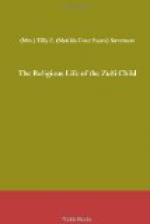to them. The third day is also spent in gathering
wood, and the fourth day likewise. On the same
day the ten men who are to personate the K[=o]-y[=e]-m[=e]-shi,
in company with the [t]S[=i]-[t]s[=i]-[t]ki (great-grandfather
of the K[=o]-y[=e]-m[=e]-shi), pass through the village,
inquiring for the boys who are to be initiated; before
such houses as have boys ready for this ceremonial
these men assemble; one of them enters the house and,
greeting the mother of the boy with “Good morning,”
inquires the name of her son. She replies:
“He has no name,” and requests the K[=o]-y[=e]-m[=e]-shi
to give him one. The man then joins the group,
repeating the words of the woman. In passing
from the kiva through the village the Indian screens
his face with a blanket, so as not to see the women
as he passes. On the fifth day they go on a rabbit
hunt, the capture of but one rabbit being necessary.
The rabbit is carried to the He-i-i-que (or Kiva of
the North) by the [t]S[=i]-[t]S[=i] [t]ki, who, after
skinning the rabbit, fills the skin with cedar bark;
a pinch of meal is placed for the heart and the eye
sockets are filled with mica; a hollow reed is passed
through the inside filling to the mouth. The sixth
day the inmates of the kivas again go for wood; the
seventh day large T[=e]-l[=i]k-tk[=i]-n[=a]-we are
made of eagle plumes; the eighth day is consumed in
decorating the masks to be worn. As these people
have not the art of mixing their pigments so as to
be permanent, masks and altars have to be freshly
decorated before using; and, when the masks are completely
decorated, they, with the other paraphernalia, are
carried on the same day by the men and youths who have
to wear them to some secluded nooks among the rocks,
a distance from the town, where they put them on,
returning to the village by early moonlight.
The impressive ceremonial of initiating the youth
into the order of the K[=o]k-k[=o] occurs but once
in four years. No male child above the age of
four years may, after death, enter the Kiva of the
K[=o]k-k[=o] unless he has received the sacred breath
of the K[=o]k-k[=o]. Those who personate the
K[=o]k-k[=o] are endowed for the time being with their
actual breath. Besides the Sae-lae-m[=o]-b[=i]-ya
of the North, West, South, East, Heavens, and Earth,
and a number of younger brothers who appear on this
occasion, there are P[=a]-oo-t[=i]-wa (Plate XX),
father of the Sun, ten K[=o]-y[=e]-m[=e]-shi, and
the K[=o]-l[=o]-oo-w[)i]t-si.
The Sae-lae-m[=o]-b[=i]-ya of the North wear yellow
(hl[=u]p-si-na) masks; those from the West, blue (hli-aen-na);
those from the South, red (shi-l[=o]-[=a]); those
from the East, white (k[=o]-h[=a]n); those from the
Heavens, all colors ([=I]-t[=o]-p[=o]-naen-ni); those
from the Earth, black (quin-n[=a]). (Plate XXI.) These
colors represent the cardinal points, the zenith,
and the nadir:
North. Yellow. Hl[=u]p-si-na.
West. Blue. Hli-aen-na.
South. Red. Shi-l[=o]-[=a].
East. White. K[=o]-h[=a]n.
Heavens. All colors. [=I]-t[=o]-p[=o]-naen-ni.
Earth. Black. Quin-n[=a].
[Plate XXI: Group of SAe-LAe-M[=O]-B[=I]-ya
masks.




